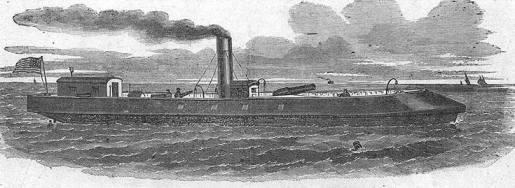 The USRC Stevens
The USRC Stevens  The USRC Stevens
The USRC Stevens
The Stevens, otherwise referred to as the "Hoboken Ironclad" from the city where she was built, was the idea of
Edwin A. Stevens, a well-known inventor, and was built by his son John Stevens in 1844. The gunboat was also known
also by the name later given by the Navy, "USS Naugatuck". The 192-ton, 110-foot-long vessel was equipped with two screws,
driven by two inclined engines with one boiler. Her main protection was her ability to partially submerge by flooding
compartments to increase her draft from 7 feet, 8 inches to 9 feet, 10 inches. In the semi-submerged state the bottom of
an armored skirt, built around her gunwales, extended to just below the surface, rendering her impervious to shipboard guns.
She awas armed with one 100 lb. Parrott rifled naval gun and two boat howitzers.
At the beginning of the Civil War, Stevens tried to donate his gunboat to the Navy, but officals refused the gift, explaining that
the untried prototype was not suitable for Navy missions. Stevens eventually donated her to the the Revenue Marine, providing them
with their first ironclad gunboat.
After serving as one of the cutters patrolling the Varrazano Narrows entrance to New York harbor, the Stevens was transferred to
Hampton Roads. She arrived shortly after the great Battle between USS Monitor and CSS Virginia. On 11 April 1862,
while stationed with the Monitor at Fortress Monroe, the Stevens engaged the CSS Virginia, firing three shots
at long range to no effect. After the destruction of the the Virginia, she was loaned to the Navy to participate in the
unsuccessful sortie up the James River to Drewry's Bluff in company with the USS Monitor, USS Galena and two other
gunboats, to attack the Confederate capital at Richmond.
After the battle at Drewry's Bluff, the Stevens was returned to
the Revenue Cutter Service and, after a brief yard period, sailed north and resumed her duties at New York harbor until the end of
the war.